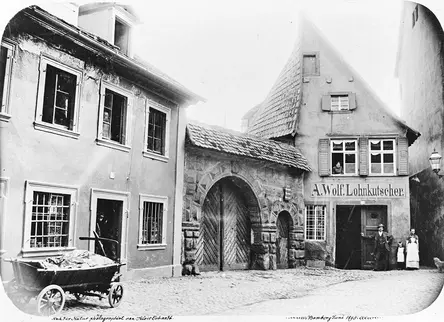A Look at the Building's Eventful History: From Private Estate to International Guest House
The Property at Fischerei 5 is situated in the back of picturesque Klein Venedig (Little Venice) in Bamberg's historic centre, and is also known as Haus zum Wasserwirt (Waterside Inn). The timber-framed house with its extraordinary half gable has been restored by the University Foundation on behalf of the University and is available as accommodation for scholars visiting the cathedral city.
By Samira Rosenbaum
"For a university whose campus is part of the World Heritage Site, a guest house in a renovated, listed building of the 16th century is an invaluable asset," says University President Prof. Dr. Kai Fischbach. "I am very pleased that my predecessor Godehard Ruppert took the initiative for this and accompanied and promoted the project together with Dagmar Steuer-Flieser, Head of Administration, Human Resources and Finance." Prof. Dr. Godehard Ruppert, former University President, describes his thoughts: "In order to attract high-ranking international researchers for collaborations, you have to offer an appropriate environment. With its location and appeal achieved through the renovation efforts, the Haus zum Wasserwirt promises an almost exclusive location advantage for the University of Bamberg." The four apartments are intended to ensure the best possible working conditions for guests.
Renovation of the Building Contributes to the Preservation of Cultural Heritage in Bamberg's Historic Centre.
This means that another listed building in the city centre belongs to the University. The restoration of the former Dominican Church and current AULA (auditorium), the altes Schlachthaus (old slaughterhouse), the former Kupfer-Faktorei (copper factory) (today: University building Am Kranen 14) or the Hochzeitshaus (wedding house) provide evidence on how the University’s use of the buildings makes a major long-term financial and non-material contribution to the preservation of cultural heritage in Bamberg's historic centre through a combination of maintenance, teaching and research. The Haus zum Wasserwirt is one of them.
In 2011, the Bamberg University Foundation acquired the building with a floor space of 195 square metres. The purchase and renovation amounted to roughly one million euros in total, largely financed by third-party grants, including, in particular, funding from the Hans L?wel Foundation and the Upper Franconia Foundation. "Honorary senator Ulf Schmitt, as chairman of the Hans L?wel Foundation, intensively advocated the project and contributed significantly to the fact that this building can now be used by the University as a guest house," says Godehard Ruppert. "Without the Honorary Senator's great commitment, we would not be able to host guests from all over the world in a University Foundation building today," affirms Dagmar Steuer-Flieser.
Thanks to Professor Gabriele Faust, the University Foundation was Able to Acquire the Haus zum Wasserwirt.
Furthermore, the former, short-term owner of the building and now deceased chair of Primary Education, Professor Dr. Gabriele Faust, contributed significantly to the success of the project. "I had told her that the University Foundation wanted to buy the Haus zum Wasserwirt and convert it into an International Guest House. Without her generous support, this would not have been possible," recalls Godehard Ruppert. Gabriele Faust, who played a decisive role in the expansion of empirical educational research at the University of Bamberg, was particularly committed to the internationalisation of the University.
The house presumably dates back to 1567/68.
Even without a precise construction date, the assumed date of origin of the Haus zum Wasserwirt can be ascertained by dating the timbers used in the roof structure: 1567/68 was determined to be the year that the timbers used were felled. "From the joinery marks and further examinations, it can be deduced that the roof structure was planned for today's ground plan," says Thomas Ei?ing, Head of the Bamberg Laboratory for Dendrochronology and Microstructure. His colleague Ruth Tenschert adds: "A schematic representation of the building is already clearly present on the Zweidler plan of 1602." The general view of the city by Petrus Zweidler at the beginning of the 17th century is the earliest preserved view of Bamberg.
The Haus zum Wasserwirt has been subject to alterations several times over the centuries: Remnants of later Baroque alterations and the changes of the 19th century can be traced on the building. The gateway, still visible in a photograph from around 1895, was closed and replaced by two windows, and the former window location was turned into an entrance. The photograph shows the inhabitants of the house in front of the gateway, above which a reference to the house owner’s profession reads: "A. Wolf, Lohnkutscher" (professional carriage driver).
Extensive Renovation Efforts Brought the Building to its Present State.
During the Second World War, changes were made to the interior of the roof: Due to the high number of refugees and the scarcity of living space, the entire attic (including the steeply pitched upper section) was used as living space. For this purpose, a window (since blocked up) was cut-out in the western gable wall and additional partition walls were added. Thus, several families could shelter there simultaneously. Before the University Foundation acquired the house, it was privately owned by Bamberg professor Dr. Gabriele Faust.
Architect Heinz Rosenberg explains: "The building was in an extremely desolate state. Usage-related and improper alterations by the previous owners, as well as a lack of building maintenance, had caused serious structural damage to the timber-framed building. Only through elaborate measures and the sensitive handling of the existing building fabric could the monument be preserved and renovated for future use. Among other things, the house was equipped with modern sanitary facilities and a heating system. Historic ceiling designs on the upper floor were preserved. The architect restored the sandstone wall on the south side, which was built in 1786, to its original state. There is now bicycle parking in a small annex. With its use as an international guest house, a new chapter in the building's history begins.
